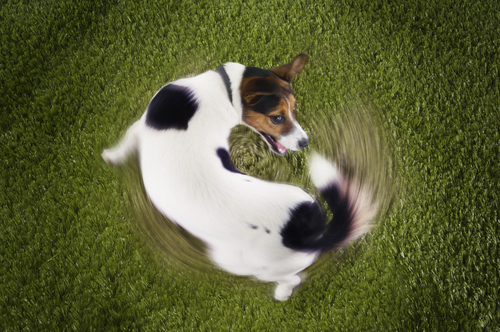We humans see certain behaviors in our dogs and think they are cute, but some of these behaviors, (like tail chasing) can be a compulsion. Compulsions are irresistible urges to behave a certain way and occur very repetitively and often. These behaviors are defined as abnormal because they seem to lack purpose and can impact the quality of life in a negative way.
Dogs can be an excellent model for human disorders and compulsive disorder is no exception. Multiple studies have found parallels in brain structure of humans suffering from Obsessive Compulsive Disorder (OCD) and dogs with compulsions. The “Obsessive” part of the term for the disorder in humans applies to thought processes and we cannot ascertain thoughts for non-verbal patients, so the name in dogs is simply Canine Compulsive Disorder. Researchers have even identified specific gene analogues when comparing affected humans and canines. 1

The compulsive actions are thought to be a method of self-soothing. They may cause release of certain hormones in the brain that are positive and calming. Other examples are repetitive circling in Belgian Malinois dogs and flank sucking in Doberman Pinschers. MRI and other diagnostic modalities have demonstrated actual structural differences in the brains of affected dogs that appear similar to the structural changes in affected human brains.2
If you have noticed your dog chasing his tail to the point that it interrupts normal life, be sure to contact your veterinarian. Your veterinarian can help figure out if your dog is trying to self soothe and may be able to make his life better with medications to avoid him needing to chase his tail. It may look funny, but it is decidedly not fun to feel driven to an action just to get through your day. Make sure that you get your dog some help.
Do you love dogs AND cats? Make sure to check out my answers to your questions at iHeartCats also! While you are laughing about all the funny things you can learn about animals, look me up on Facebook by clicking here.
- Repetitive behaviors in cats and dogs: Are they really a sign of obsessive-compulsive disorders (OCD)? Can Vet J. 2013 Feb; 54(2): 129–131, Diane Frank.
- Candidate genes and functional noncoding variants identified in a canine model of obsessive-compulsive disorder. Genome Biol.2014 Mar 14;15(3):R25. doi: 10.1186/gb-201415-3-r25.Tang R, Noh HJ, Wang D, Sigurdsson S, Swofford R, Perloski M, Duxbury M, Patterson EE, Albright J, Castelhano M, Auton A, Boyko AR, Feng G, Lindblad-Toh K, Karlsson EK.
- Environmental effects on compulsive tail chasing in dogs.PLoS One.2012;7(7):e41684. doi: 10.1371/journal.pone.0041684. Epub 2012 Jul 26. Tiira K, Hakosalo O, Kareinen L, Thomas A, Hielm-Björkman A, Escriou C, Arnold P, Lohi H.
